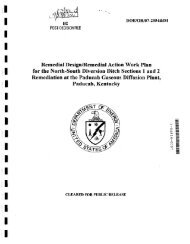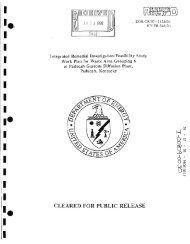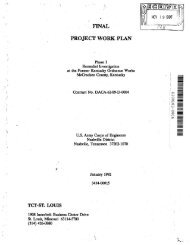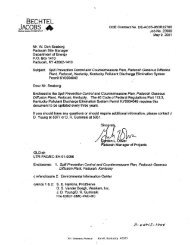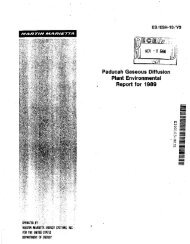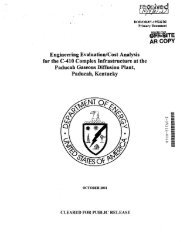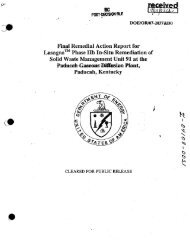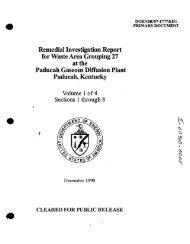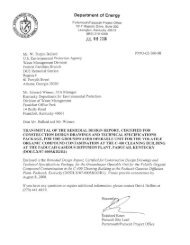1 - paducah environmental information center
1 - paducah environmental information center
1 - paducah environmental information center
Create successful ePaper yourself
Turn your PDF publications into a flip-book with our unique Google optimized e-Paper software.
Paducah Site<br />
beneficial to the patients exposed. Generally,<br />
diagnostic or therapeutic medical exposures<br />
result from X ray beams directed to specific areas<br />
of the body. Thus, all body organs generally are<br />
not irradiated \lniformly. Radiation and<br />
radioactive materials are also used in a wide<br />
variety of pharmaceuticals and in the preparation<br />
of medical instruments, including the sterilization<br />
of heat-sensitive products such as plastic heart<br />
valves. Nuclear medicine examinations and<br />
treatment involve the internal administration of<br />
radioactive compounds, or<br />
radiopharmaceuticals, by injection, inhalation,<br />
consumption, or insertion. Even then,<br />
radionuclides are not distributed uniformly<br />
throughout the body.<br />
Other Sources<br />
LlQUID'EFFU.UENT<br />
~ 9~-<br />
- '. CROP<br />
-- .i DEPOSITION<br />
-4fI" ~<br />
__,..~...... --'" GROUND<br />
~ __,.,.__ . DEPOSITION<br />
-<br />
'-...DIRECT<br />
RADIATION<br />
~<br />
Figure A.3 Posslble:radlatlonipathways.<br />
Other sources of radiation include fallout<br />
from atmospheric atomic weapons tests;<br />
emissions of radioactive materials from nuclear<br />
facilities such as uranium mines, fuel processing<br />
plants, and nuclear power plants; emissions from<br />
mineral . extraction facilities; and transportation<br />
of radioactive materials.<br />
PATHWAYS OF RADIATION<br />
Radiation and radioactive material in the<br />
environment can reach people through many<br />
routes. Potential routes for radiation are referred<br />
to as pathways. For example, radioactive<br />
material in the air could fallon a pasture. The<br />
grass could then be eaten by cows, and the<br />
radioactive material on the grass would show up<br />
in the cow's milk. People drinking the milk<br />
would thus be exposed to this radiation. Or,<br />
people could simply inhale the radioactive<br />
material in the air. The same events could occur<br />
with radioactive material in water. Fish living in<br />
the water would be exposed; people eating the<br />
fish would then be exposed to the radiation in the<br />
fish. Or, people swimming in the water would be<br />
exposed (Figure A.3).<br />
MEASURING RADIATION<br />
To determine the possible effects of<br />
radiation on the environment and the health of<br />
people, the radiation must be measured. More<br />
precisely, its potential to cause damage must be<br />
determined.<br />
Activity<br />
When measuring the amount of radiation in<br />
the environment, what is actually being<br />
measured is the rate of radioactive decay, or<br />
activity. The rate of decay varies widely among<br />
the various radioisotopes. For that reason, 1 g of<br />
a radioactive substance may contain the same<br />
amount of activity as several tons of another<br />
material. This activity is expressed in a unit of<br />
measUre known as a curie (Ci). More<br />
specifically, 1 Ci = 3.7E+1O (37,000,000,000)<br />
atom disintegrations per second (dps). In the<br />
international system of units, 1 dps = 1 becquerel<br />
(Bq).<br />
A-4<br />
Appendix A



